Art & Exhibitions
In a Solo Show at the Munch Museum, Artist Camille Henrot Tackles the Traumas of Motherhood, Hoarding, and Fitting In
After winning the inaugural Edvard Munch Art Award in 2015, the French artist finally gets her solo show in Oslo.
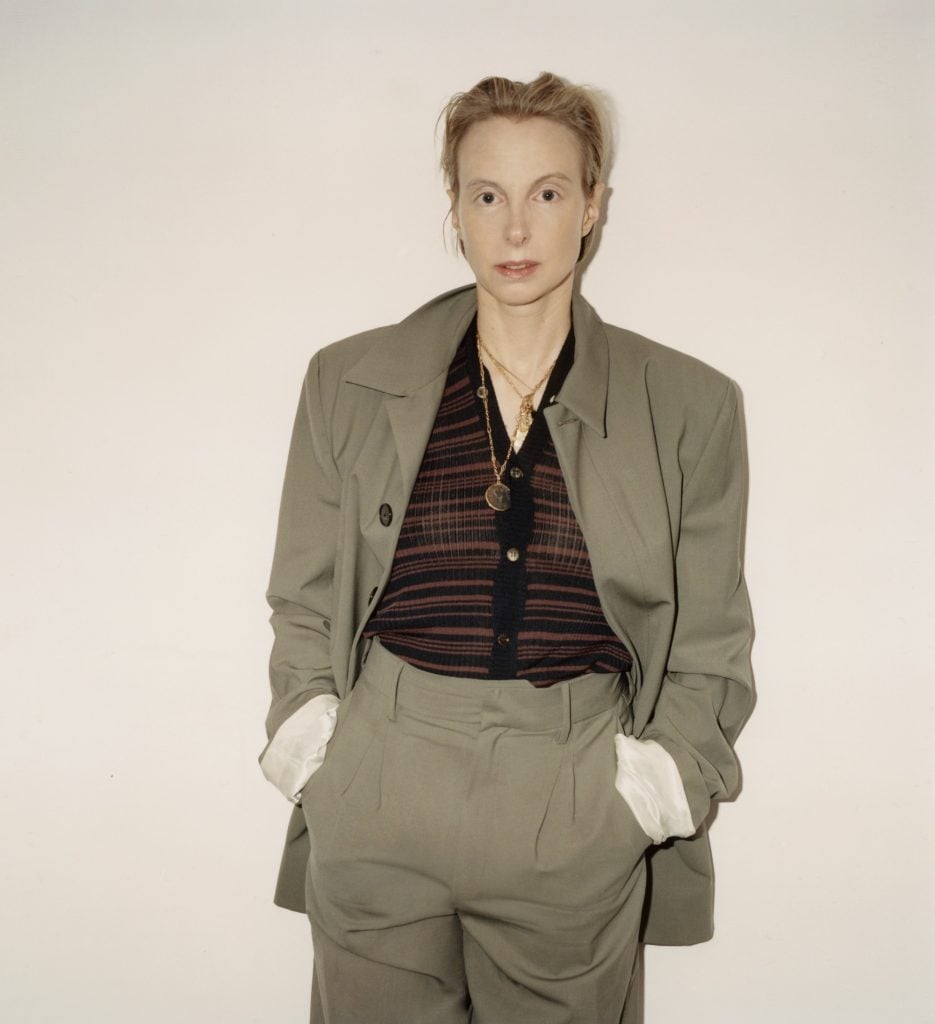
After winning the inaugural Edvard Munch Art Award in 2015, the French artist finally gets her solo show in Oslo.

Anna Sansom

“There is a very deep ambivalence in all relationships, but the more intimate and closer the relationship, the more ambivalent it will be,” said the French artist Camille Henrot at the opening of her exhibition, “Mouth to Mouth,” at the Munch museum in Oslo.
Ambivalence might be an overarching theme in the exhibition, taking place on the ninth floor of the waterfront museum that opened last year to house the world’s largest collection of paintings by Edvard Munch, the Norwegian artist best known for The Scream. But it is the psychologically charged aspect of Henrot’s work that draws the closest comparisons to Munch’s.
The French-born, New York-based artist, who works across video, paintings and sculpture, was the winner of the inaugural Edvard Munch Art Award in 2015. Worth 500,000 Norwegian kroner ($50,000), the prize is given to an international artist no older than 40, and includes an exhibition at the museum.
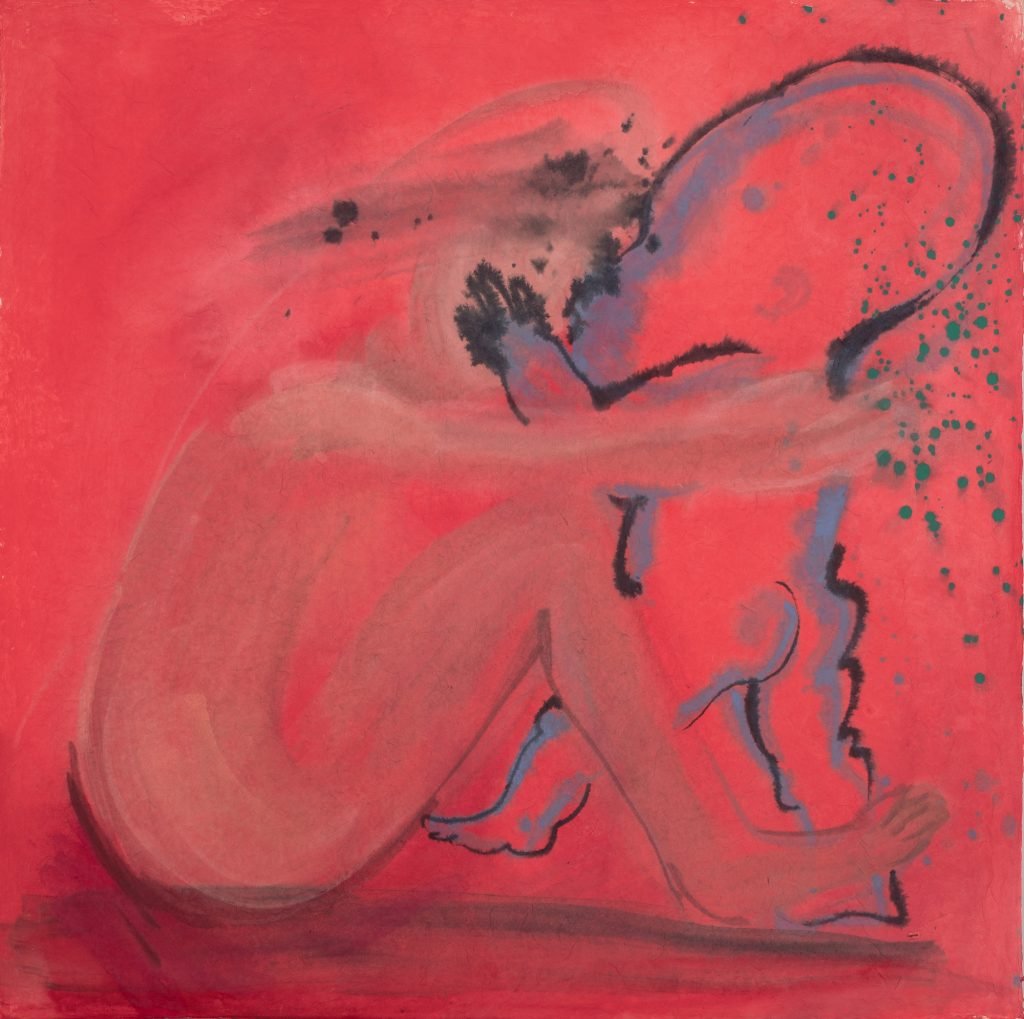
Camille Henrot, Big Kiss (2019), watercolor and ink on Japanese paper. © Camille Henrot. Courtesy the artist and Hauser & Wirth.
After winning the Munch award, Henrot had to wait seven years to have her solo show in Oslo, as the museum, designed by Spanish architects Estudio Herreros, was being constructed. Her vision for the show changed in the interluding years, during which she had a large-scale exhibition, “Days are Dogs,” at the Palais de Tokyo in Paris, in 2017.
“When I received the Munch award, the connection between my work and that of Edvard Munch was not particularly obvious and it doesn’t have to be,” Henrot said. “But somehow, this new body of work around language, primal fear and early development in our life, has much more to do with his work.”
Her unframed watercolor paintings capture the complexity of human relationships, such as those between mother and child, or between lovers. The works “caress” the walls, in the words of exhibition curator Tominga O’Donnell, thanks to a specially designed system of magnets. “Camille is an incredible artist who approaches the exhibition like it’s a total installation,” O’Donnell says.
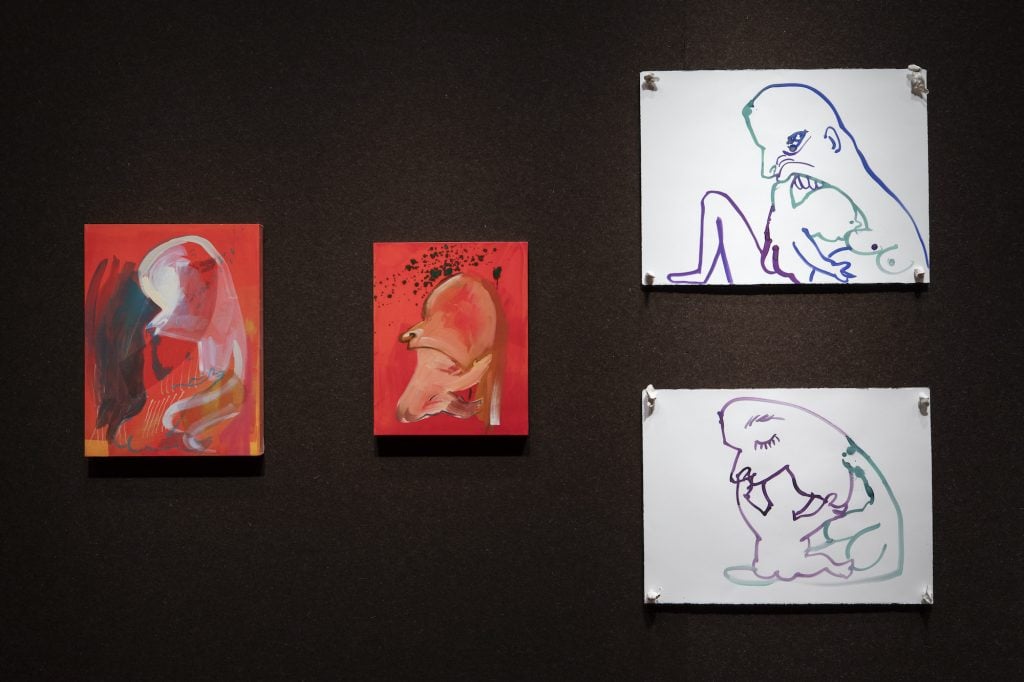
Installation view of “Camille Henrot: Mouth to Mouth,” at the Munch museum in Oslo. © Camille Henrot. Photo: Munch museum. Courtesy of the artist and Hauser & Wirth.
The paintings, many of them in red or yellow, with the figures boldly outlined in black, belong to Henrot’s ongoing “Systems of Attachment” series, started in 2018. A whole gamut of emotions is portrayed, from tenderness to anger. One painting depicts a mother and a child kissing; in others, a mother is biting and devouring her child, or a child is holding up its mother’s mouth and biting her nipples.
As research for this theme, Henrot said she read Austrian-British psychoanalyst Melanie Klein’s writing on her Object Relations Theory about the mother-child relationship. Henrot began the series as a way to explore her feelings about childhood, as well as her experience of becoming a mother. “There were a number of intense physical sensations and even trauma associated with my own childhood that I felt was probably driving my work at that moment,” she said.
Believing that women artists portraying such subjects are still looked at pejoratively—and noticing a dearth of artworks—Henrot tackles motherhood, and the labor of breastfeeding, from a feminist and political stance. Her exhibitions, “Wet Job” and “Mother Tongue,” held earlier this year at Belgium’s Middelheim Museum and Austria’s Salzburger Kunstverein respectively, both explored the subject.
Referring to how her oeuvre touches on a difficult subject, Henrot said: “Even women themselves have a disgust of motherhood; we all have a disgust of our own mother, because that’s where we come from. In a patriarchal society, we’ve been taught to disrespect mothers and devalue their work.”
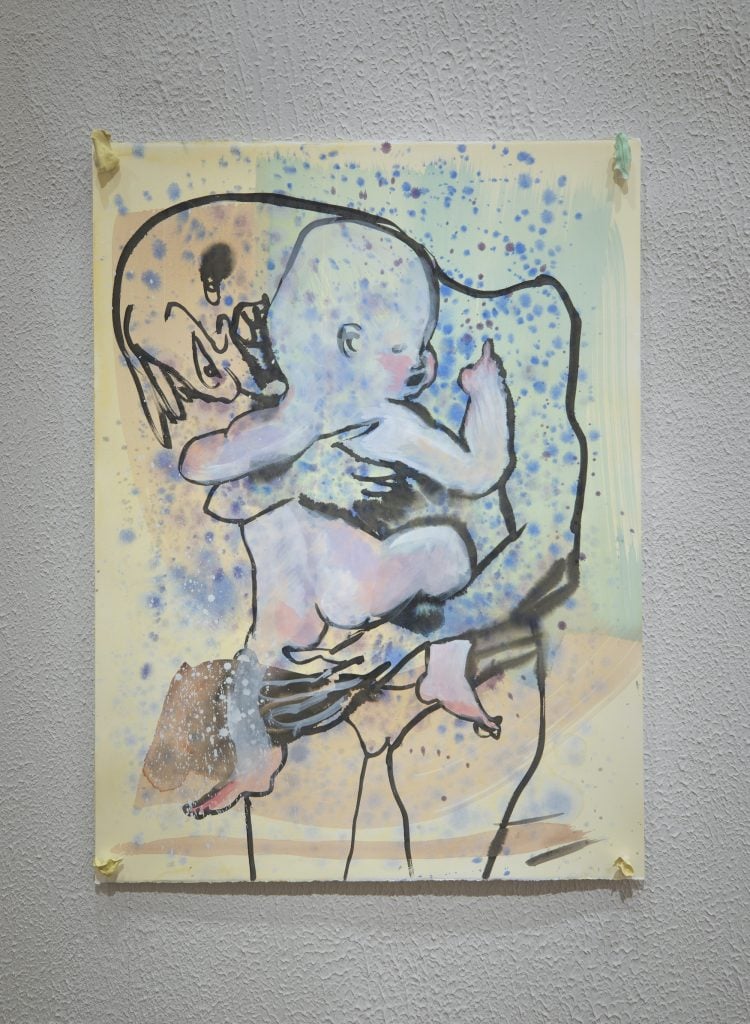
Installation view of “Camille Henrot: Mouth to Mouth,” at the Munch museum in Oslo. © Camille Henrot. Photo: Munch museum. Courtesy of the artist and Hauser & Wirth.
“I’ve seen no images of [breast pumping] even though it’s a very important primal thing,” Henrot added. “There are images of sex, death, every possible kinky, intense, dirty aspect of being human, but this image is nowhere and I was very intrigued by that.”
Born in Paris in 1978, Henrot studied at the École Nationale Supérieure des Arts Décoratifs, the French capital’s decorative arts school, where she specialized in animation. After graduating, she moved to New York and made experimental music videos while working as an assistant for French artist Pierre Huyghe. Some of her videos were noticed by the art world, inspiring Henrot to make longer films.
Her big break came when curator Massimiliano Gioni presented her compelling video Grosse Fatigue in “The Encyclopedic Palace,” the main exhibition at the Venice Biennale in 2013, where she won the Silver Lion Award for promising young artists.
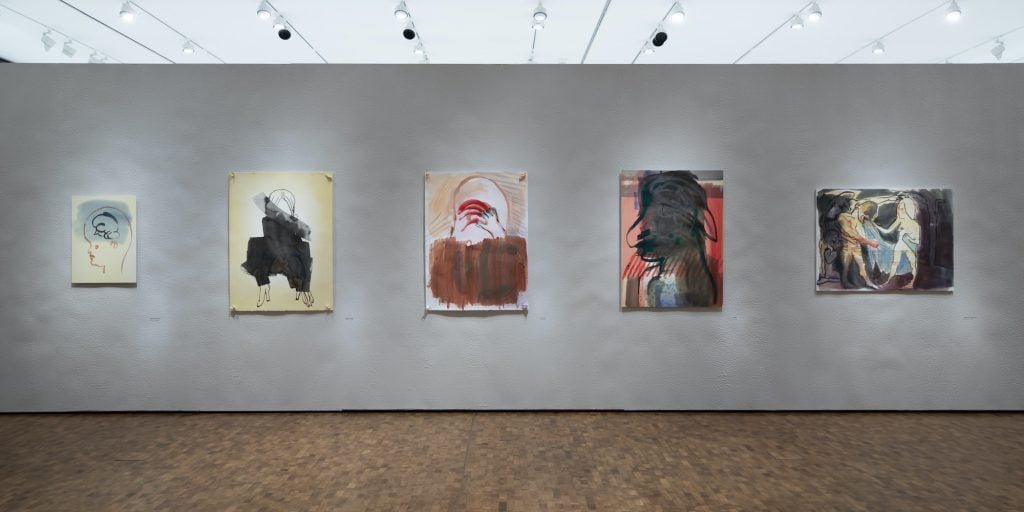
Installation view of “Camille Henrot: Mouth to Mouth,” at the Munch museum in Oslo. © Camille Henrot. Photo: Munch museum. Courtesy of the artist and Hauser & Wirth.
Grosse Fatigue tells the history of the universe through a vast breadth of images colliding across a computer screen while recognizing the inherent failure in the narrative attempt. It was created thanks to a Smithsonian Artist Research Fellowship, which allowed Henrot to film the collections of several American museums.
“I remember telling Massimiliano the different ideas that I had and he interrupted me, saying: ‘No, you just have to do a master work.’ I thought ‘Oh, my God’ and decided to embrace that sense of panic in the film.”
Rather than writing a cohesive narrative, Henrot made a storyboard in order to keep the possibilities open and let the editing be intuitive. The key was in making the images look random and for the structure to be invisible. “What’s interesting about the film’s format is that you can call upon the viewer’s ability, intelligence and memory of association and experiences,” she said.
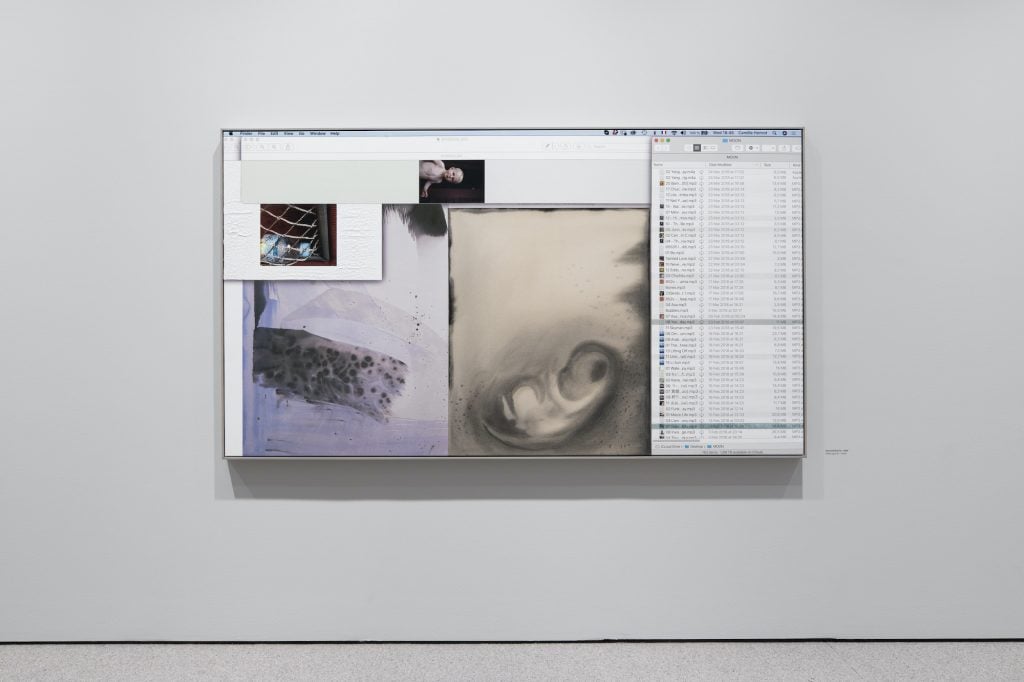
Installation view of “Camille Henrot: Mouth to Mouth,” at the Munch museum in Oslo. © Camille Henrot. Photo: Munch museum. Courtesy of the artist and Hauser & Wirth.
Henrot said that the making of Grosse Fatigue was born out of a problematic situation when she relocated to the US. “I had no studio and the computer was the only tool I had,” she recollects. “I was working in pajamas in my bed. The computer window was my whole world.”
Prior to moving across the Atlantic, Henrot had acquired a mass of objects on eBay—including animal parts and pornography—that were blocked by U.S. customs. This accumulation would form the basis of her installation piece, The Pale Fox (2014), which, she said, “is a bit like a metaphor of the museum, [about someone] who is greedy and wanting to accumulate everything.”
During the Covid-19 pandemic, Henrot once again found herself in a state of disequilibrium. Having lost her New York studio, she moved back to France to stay with her mother not far from Paris. While ordering and decluttering the library, Henrot found her mother’s books on etiquette. The rather antiquated tomes inspired her series “Dos and Dont’s,” on view at the Munch museum. “My mum is a hoarder; I’m a hoarder,” she said, smiling.
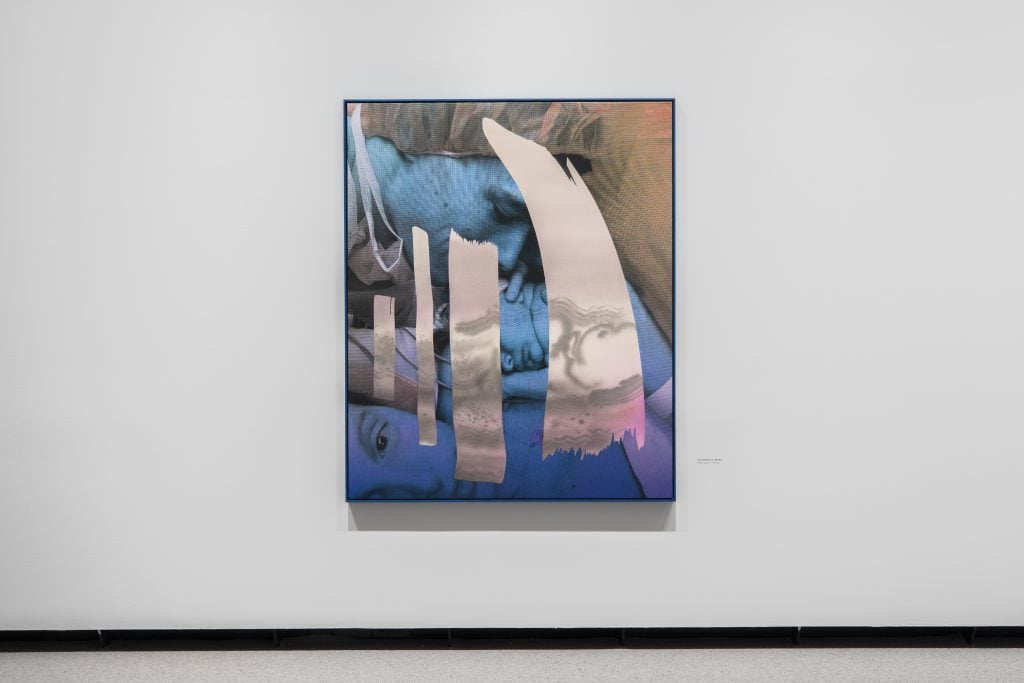
Camille Henrot, Dos and Don’ts – My Bio (2020), digital collage serigraph print with watercolor, ink, acrylic and oil on prepared canvas. © Camille Henrot. Courtesy the artist and Hauser & Wirth.
The multimedia pieces combine screenshots, computer-generated images, photographs, paintings, playlists and wordplay. The series – which involves her revisiting the idea of the computer window for the first time since Grosse Fatigue – draws an analogy between etiquette and the process of manipulation, by both digital and traditional means.
“It’s a back-and-forth where I’m scanning real brushstrokes then manipulating them on Photoshop so they look like digital brushstrokes,” Henrot said. “There are prints of paintings, and paintings imitating the computer window, and cracks. I was working a lot with a graphic palette on Photoshop which is weirdly named ProCreate.”
Describing how she amasses images and ideas from multiple sources, Henrot said: “Looking at them when I take a step back, I’m asking myself: ‘Why did I collect that image, what’s interesting in it for me?’ Then I print all the images, and organize them in categories or in Dropbox—I change the places a thousand times. It’s almost borderline because I feel as if I’m losing my mind deciding where they’ll go.”
Although the “Dos and Dont’s” series seems witty, there is something slightly sinister underpinning the references to the etiquette books, Henrot said. “It looks like I’m talking about something very inoffensive, obsolete and ridiculous, but it turns out to be a good metaphor for the world of control and surveillance,” she explained. “Like children, we are under parental control. In every rebellion to injustice, we have a sense of powerlessness, an experience that is very strong when we are children. I don’t identify with the mother, I identify with the child in everything I do.”
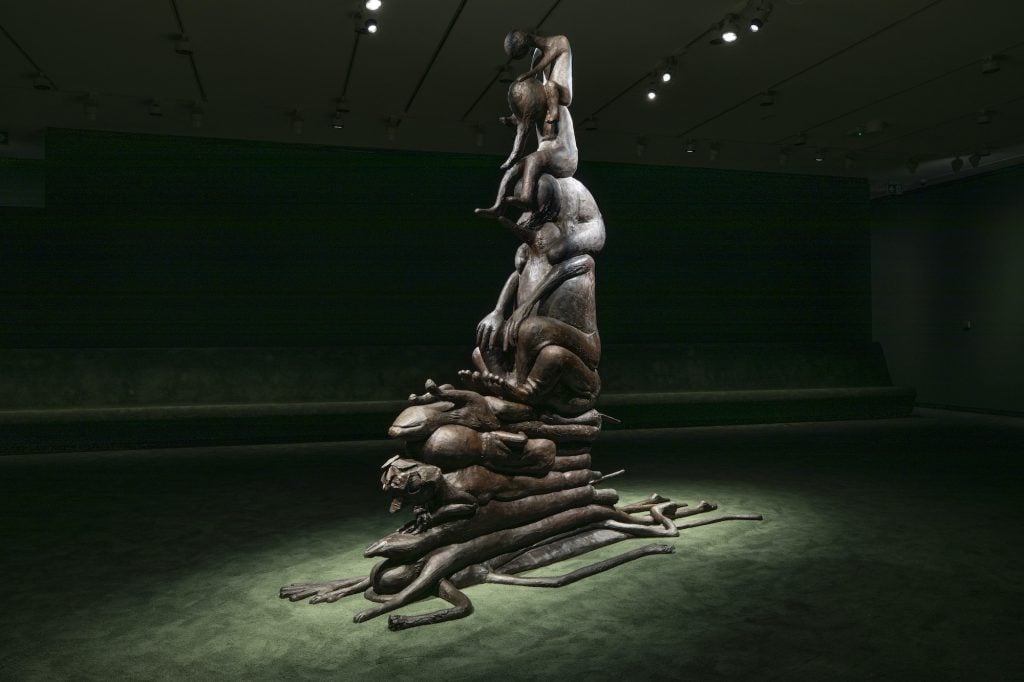
Installation view of “Camille Henrot: Mouth to Mouth,” at the Munch museum in Oslo. © Camille Henrot. Photo: Munch museum. Courtesy of the artist and Hauser & Wirth.
Also on view in Oslo are two bronze sculptures: a monumental work of animals reclining on top of each other, inspired by the fairytale “The Bremen Town Musicians,” and Misfits. The latter is a large cube with cut-out triangles, circles and squares; the corresponding shapes are squeezed haphazardly into the wrong slots, or are discarded on the ground. “There is a certain violence in things being unilateral, being able to function only in a certain way,” Henrot said.
Offering insight into her wide-reaching practice and manner of flitting seamlessly between ideas, she mused: “I think I’m someone who strives in multiplicity. In a way, I am drifting a lot. I like to keep things very open.”
“Camille Henrot: Mouth to Mouth” is on view at the Munch museum in Oslo, through 19 February 2023.
More Trending Stories:
Disgraced Antiques Dealer Subhash Kapoor Handed a 10-Year Jail Sentence by an Indian Court
Click Here to See Our Latest Artnet Auctions, Live Now